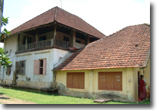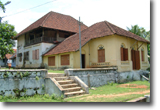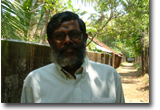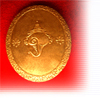 |
Personalities KILIMANOOR RAJA RAJA VARMA KOITHAMPURAN (1812-1845) (Alias Cherunni/Kareendran) |
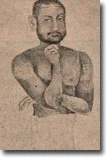 |
Swathi
Thirunal's court had many stalwarts, but the closest to his heart
was undoubtedly his childhood friend Kilimanoor Raja Raja Varma Koithampuran
known as Cherunni Koithampuran and nicknamed Kareendran by Swathi
(Koithampuran was said to have had a stout body and was dark in complexion;
Kareendran means king elephant). Swathi Thirunal's mother's sister
Rani Gauri Parvathi Bai was married to Raghava Varma Koithampuran
in ME 988 (she married once again after her first husband died 996.
The second husband was also from Kilimanoor palace. He too died in
1000 ME). |
|
Sometime after 988, Rani Parvathi visited and stayed at Kilimanoor palace, along with Swathi (It is said that they stayed in a two storeyed building, the front extension of which is seen from the arch gate. This extension today houses exhibits related to Raja Ravi Varma, a famous painter hailing from Kilimanoor palace). Swathi met Kilimanoor Raja Raja Varma Koithampuran known as Cherunni, at this palace and they quickly became bosom friends, with both having craze in Sanskrit poetry. Rani Parvathi took along with her Cherunni when she returned to Thiruvananthapuram. Cherunni stayed in the palace at Thiruvananthapuram and underwent studies along with Swathi. As soon as Swathi assumed the throne, Cherunni was given a monthly grant of Rs.100/- and later was given the Veera Shringala and the title 'Vidwan'. Vidwan Koithampuran is known to have authored Kiratha Vimsathi (Sanskrit Stothra), two keerthanas, Raavana Vijayam (aattakatha) and Santhana Gopalam( Sheethangan Thullal). Once when Swathi mentioned naazhikamaniyaaraayi, Kareendran took it as the first stanza of a poem and completed the second stanza as nareenaam bhooshanaukamaniyaaraayi. He further added: vasaramanayarayi, kokeenamashrujalamanayarayi!” Kareendran is known to have attracted Swathi's displeasure, and he was sent out of the palace due to the gossip machinery going against him. In 1845 December, an year before Swathi's demise, Kareendran passed away. Swathi, already shaken by the death of his nephew, Pooyam Thirunal (4 years) in 1837, his own sister Rugmini Bhai in 1837 itself, his father in 1844 and Vadivelu in 1845, is said to have remarked that the soul of his Durbar was lost with Kareendran's death.
|
